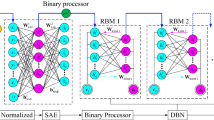Abstract
Traditional fault diagnosis for a high-voltage circuit breaker (HVCB) encounters the following problems: the fault features extracted by traditional shallow models is of weak expression ability, and the accuracy of fault identification can be affected by the lack of labeled training samples. To overcome these problems, we present a new approach for HVCB mechanical fault diagnosis based on a deep belief network (DBN) and a transfer learning strategy. This approach uses a DBN to achieve the deep mining and adaptive extraction of the inherent features of sample data, and combines the transfer learning method to improve the accuracy of the fault diagnosis model, which uses a large amount of selective auxiliary data to augment the tiny amount of target data learning by adjusting the weight of training samples. The target sample data are obtained by collecting the coil current signal of the HVCB from fault simulation experiments, and the auxiliary sample data are obtained through simulation based on the electromagnetic system mathematical model of the HVCB spring mechanism. The experimental results show that compared with the traditional feature extraction and fault diagnosis method, the DBN approach combined with transfer learning can achieve stronger feature learning and generalization ability.













Similar content being viewed by others
References
Zhang X, Gockenbach E, Liu Z, Chen H, Yang L (2013) Reliability estimation of high voltage SF6 circuit breakers by statistical analysis on the basis of the field data. Electr Power Syst Res 103:105–113
Mei F, Mei J, Zheng JY et al (2013) Development and application of distributed multilayer on-line monitoring system for high voltage vacuum circuit breaker. J Electr Eng Technol 8(4):813–823
Janssen A, Makareinis D, Solver CE (2014) International surveys on circuit-breaker reliability data for substation and system studies. IEEE Trans Power Deliv 29(2):808–814
Forootani A, Afzalian AA, Ghohmshe AN (2016) Model-based fault analysis of a high-voltage circuit breaker operating mechanism. Turk J Electr Eng Comput Sci 25(3):2349–2362
Zhu K, Mei F, Zheng J (2017) Adaptive fault diagnosis of HVCBs based on P-SVDD and P-KFCM. Neurocomputing 240:127–136
Liu GQ, Gao Y, Yang L (2016) High-voltage circuit-breaker fault diagnosis based on mechanical vibration signals. Rev Tech Fac Ing Univ Zulia 30(4):387–394
Razi-Kazemi AA, Vakilian M, Niayesh K (2014) Circuit-breaker automated failure tracking based on coil current signature. IEEE Trans Power Delivery 29(1):283–290
Yang Z, Liang LIANG, Li X (2015) Application of the Gray correlation model in fault diagnosis of high-voltage circuit breakers. Power Syst Technol 39(6):1731–1735
Van M, Kang H (2016) Bearing defect classification based on individual wavelet local fisher discriminant analysis with particle swarm optimization. IEEE Trans Ind Inform 12(1):124–135
Hwang DH, Youn YW, Sun JH et al (2015) Support vector machine based bearing fault diagnosis for induction motors using vibration signals. J Electr Eng Technol 10(4):1558–1565
Agrawal S, Giri VK (2017) Improved mechanical fault identification of an induction motor using Teager-Kaiser energy operator. J Electr Eng Technol 12(5):1955–1962
Su Z, Tang B, Liu Z et al (2015) Multi-fault diagnosis for rotating machinery based on orthogonal supervised linear local tangent space alignment and least square support vector machine. Neurocomputing 157:208–222
Jin X, Zhao M, Chow TWS et al (2014) Motor bearing fault diagnosis using trace ratio linear discriminant analysis. IEEE Trans Industr Electron 61(5):2441–2451
Hinton GE, Salakhutdinov RR (2006) Reducing the dimensionality of data with neural networks. Science 313(5786):504–507
Huang WZ, Zhang SW (2017) A novel face recognition algorithm based on the deep convolution neural network and key points detection jointed local binary pattern methodology. J Electr Eng Technol 12(1):363–372
Mohamed AR, Dahl GE, Hinton GE (2012) Acoustic modeling using deep belief networks. IEEE Trans Audio Speech Lang Process 20(1):14–22
Basu S, Karki M, Ganguly S et al (2017) Learning sparse feature representations using probabilistic quadtrees and deep belief nets. Neural Process Lett 45(3):855–867
Tamilselvan P, Wang P (2013) Failure diagnosis using deep belief learning based health state classification. Reliab Eng Syst Safety 115:124–135
AlThobiani F, Ball A (2014) An approach to fault diagnosis of reciprocating compressor valves using Teager-Kaiser energy operator and deep belief networks. Expert Syst Appl 41(9):4113–4122
Shao H, Jiang H, Zhang X et al (2015) Rolling bearing fault diagnosis using an optimization deep belief network. Meas Sci Technol 26:11
Hinton GE, Deng L, Yu D, Dahl GE, Mohamed A, Jaitly N (2012) Deep neural networks for acoustic modeling in speech recognition: the shared views of four research groups. IEEE Signal Process Mag 29:82–97
Krizhevsky A, Sutskever I, Hinton GE (2012) ImageNet classification with deep convolutional neural networks. Adv Neural Inf Process Syst 25:1106–1114
Zhuang FZ, Luo P, He Q et al (2015) Survey on transfer learning research. J Softw 26(1):26–39
Shell J, Coupland S (2015) Fuzzy transfer learning: methodology and application. Inf Sci 293:59–79
Wei F, Zhang J, Chu Y et al (2014) FSFP: transfer learning from long texts to the short. Appl Math Inf Sci 8(4):2033–2040
Hinton GE (2002) Training products of experts by minimizing contrastive divergence. Neural Comput 14(8):1771–1800
Pan SJ, Yang Q (2010) A survey on transfer learning. IEEE Trans Data Eng 22(10):1345–1359
Dai W, Yang Q, Xue GR et al (2007) Boosting for transfer learning. Icml 238(6):1855–1862
Li Q-M, Qian J-L, Huan Y-L et al (2004) Converse analysis dynamic characteristics of operating electromagnets in high voltage circuit breakers. Proc CSEE 24(6):127–131
Sun Y, Zhang W, Zhang Y (2015) Research on feature value extraction and fault recognition of coil current signal in high-voltage circuit breaker. High Volt Appar 51(9):134–139
Acknowledgements
This work was supported by the China Postdoctoral Science Foundation (Grant no. 2015M571654).
Author information
Authors and Affiliations
Corresponding author
Rights and permissions
About this article
Cite this article
Pan, Y., Mei, F., Miao, H. et al. An Approach for HVCB Mechanical Fault Diagnosis Based on a Deep Belief Network and a Transfer Learning Strategy. J. Electr. Eng. Technol. 14, 407–419 (2019). https://doi.org/10.1007/s42835-018-00048-y
Received:
Revised:
Accepted:
Published:
Issue Date:
DOI: https://doi.org/10.1007/s42835-018-00048-y




